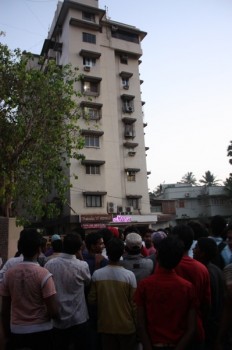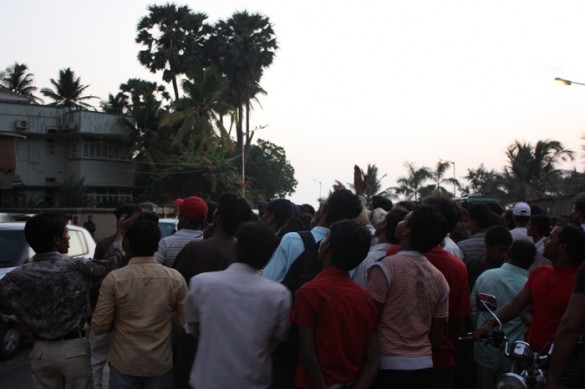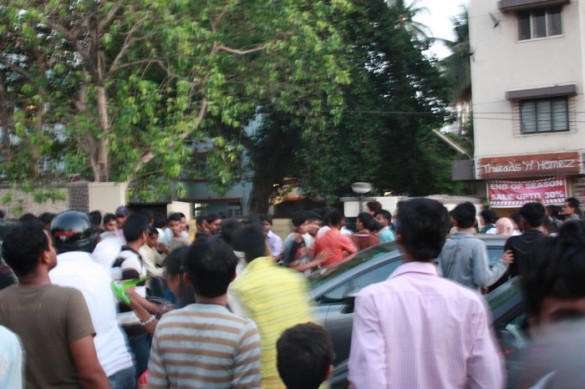The first time the security man raises his long bamboo stick, the crowd surges back with such unexpectedly swift cohesion that by the time I realize what’s happening, I’m swept backwards and pinned against a wire mesh fence. For a brief, jarring moment I’m certain my recurring third world nightmare of death-by-trampling is about to become a reality.
But I’m not protesting in the streets of Bangkok or battling for democracy in Tehran–I’m out for an evening stroll along one of the most posh seaside strips in Mumbai. It’s my last night of a week in India’s mega-metropolis, a place where the country’s glittery Nouveau Riche collide with its impoverished masses in an urban mash-up that, depending on your viewpoint, is a rhythmic maze of wonders or just a chaotic, overwhelming maze.
Check out these indie travel tips for visiting Mumbai.

The mob in question has filled the sidewalk and is spilling into the street directly outside a drab, nine-story apartment building. All eyes are fixated on the tower’s first floor, which, as I was informed a few minutes ago by an overexcited 20-something Mumbaikar, is the residence of “very, very, very, very, very famous movie star Salman Khan.”
I glance up at the apartment’s simple barred windows, perched above a street-level retail shop with signage reading “Threds ‘n’ homez – end of season sale – up to 30% off.” This doesn’t look like the home of even a very, very, famous movie star. I study the hundreds of eager eyeballs glued expectantly upwards, then turn quizzically back to the young man set on explaining things.
“Salman Khan house,” he repeats, bobbing his head insistently. “You know Salman Khan, yes?” I’m vaguely familiar with the name and nod half-heartedly, but my new friend seems shocked to find his declaration met with anything less than full-throttled ecstasy.
Later research would reveal Salman Khan to be quite the colorful character, equally famous for his bulging biceps and beefcake-y movie roles as for his turbulent dalliances with gorgeous co-stars, petty feuds with rival male actors, and frequent brushes with the law–ranging from an arrest for hunting an endangered chinkara gazelle to allegedly running over and killing a homeless man. Rounding out this almost cartoonish biography, the 45-year-old megastar doesn’t live in a mansion-bungalow like other A-list Indian actors, but with his parents in the relatively modest apartment tower where he grew up.
But I know none of this as I take in the mob of fervent fans gathered outside Kahn’s building, looking quite unlike the half-bored, Star Maps-clutching tourists hoping for celebrity glimpses in Beverly Hills and Malibu. For starters, the fans here are almost exclusively young men, and they seem to approach gawking at movie stars with all the intensity of overthrowing governments.

The youngest and most excited of the men, early teenagers, are concentrated at the front of the crowd, heads craned upwards, hands waving wildly at the apartment above. As I watch from the other side of the street, a few of these young men in front begin moving a little closer to the building’s gates, then those behind them move a little closer themselves, and soon a ripple effect has the entire group slowly and uniformly creeping towards the guarded gate. Peering up from the back, I wonder if the whole crowd isn’t about to spill right over the wall into the apartment building’s driveway. But then one of the guards raises his nightstick threateningly in the air, instantly sending the entire fleet scurrying backwards. The ripple effect switches into reverse and doubles in speed, and before I catch the new momentum I’m half-crushed between a wave of teenagers and said wire fence.
Fortunately, it’s only a few seconds before the crowd catches its collective breath and uniformly begins tiptoeing back towards the apartment, reversing the flow of humanity and giving me some breathing room. Against my better judgment, I’m drawn to move with them, eager to understand what’s driving this chaotic scene. For a few minutes everything appears fully under control, more American Idol set than frantic mob scene, the hundreds of young men once again waving gleefully and shouting towards Khan’s apartment. But suddenly, and with no apparent warning or instigation, the front of the crowd stops creeping and surges forward as if determined to storm the gates, with those in the back quickly following them across the street. Traffic stops, honking ensues, a bus stalls and the young men engulf it, banging the windows and hollering as if the megastar himself might be riding up in this decrepit public transport. The guards tolerate all this for a minute or two, and then, as soon as one of them lifts a threatening stick, every participant turns and flees without a hint of resistance. This time I scuttle aside quickly to avoid death-by-trampling, a concern that seems to worry not a single other person.
By the third or fourth go-around I realize there’s a reliable cycle to this madness. The crowd thrives on the communal thrill of inching towards the gate and then sprinting away, and I should note that the guards don’t ever actually strike anyone. I should also note that not once does so much as a flicker of a light or a jostle of a window shade indicate that Salman Khan, or anyone else, is inside the fully darkened apartment. But that’s entirely beside the point, and by this time I’m as entertained as anyone, caught up in this rhythmic, inexplicable stakeout. Every passing auto-rickshaw driver stops (well, slows down–no one ever really stops here) and offers to whisk me back to the safety of a hotel for a very good price, but I turn them down and stick to my spot at the back of the crowd.
In between surges, many of the young men stop to talk to me, amused by my passive participation and eager to offer an explanation of this raucous scene, the inevitable extent of which is a forceful finger pointed at the apartment and an enthusiastic proclamation of their shared mantra–“Salman Khan house!”–their amplified gestures proclaiming, “can you believe he’s really here?” I haven’t the heart or the language skills to explain that I would, in fact, believe it if he was here, but I’m pretty sure that he isn’t.
As I alternately shrug apologetically and nod with fake recognition, one fan whose English is a little better than most fires off a string of film titles as explanation. “Wanted…Partner… No Entry,” he proclaims, listing Khan’s movies as if they are commandments. “And–” he exclaims triumphantly, sure he has the trump card to wow he out of my ignorance, “his wife–Katrina Kaif!” He stares with wide-eyed, nodding anticipation, waiting for me to react as if he has just told me Khan was betrothed to Mary, Mother of God.
Taking advantage of his comparatively strong English, I fish for a fuller explanation of this frantic scene. “Is he even home?” I ask. “Does he ever come outside?”
“Yes, yes, we see him,” he insists. “Last week I go up to his house. He invited me specially.” I’m fairly certain this claim is about as likely as Brad and Angelina inviting a pair of paparazzi up to their Hollywood Hills mansion for afternoon tea, but I don’t get a chance to hear more of his tale, because the guard’s stick is once more raised high and it’s time for the group to reverse and run.

This time the crowd turns and surges back with such speed that I wonder if this is the moment when it will get really ugly, if perhaps someone’s head is about to get bashed in. But nothing of the sort occurs, and not 30 seconds later everything is disconcertingly back to normal, the throngs pushed back to either sidewalk, the streets now clear and the guard’s baton sheathed. One of Mumbai’s omnipresent tea salesmen passes through hawking chai from a pot balanced on his head, and I can’t help but laugh at the absurdity of this, as if we weren’t just in the middle of a near-riot, but casually sipping drinks at a cricket match. An Armani-clad club-goer strolls through chatting on his iPhone, not giving the scene or anyone involved a second glance. How is it possible, I demand to know from the city as a whole and from no one in particular, that we are less than a minute removed from pure and utter chaos?
But by now I realize we never were in chaos at all, only caught in a tiny corner of Mumbai’s manic urban maze, swept up by that frantic pace of life that perennially seems ready to spin out of control but somehow never does. After spending the better part of my week here gawking rather horrified at this city’s insane pace of life–the frantic bazaars, the diesel-spewing traffic, the ridiculously overcrowded train cars–it’s not until these last few hours, dodging stampeding 19-year-olds, jumping above the star-crazy crowds and preening for a glimpse of a man I’ve never heard of and am fairly certain is not at home, that I finally catch Mumbai.
Brendan Spiegel‘s travel writing has appeared in The New York Times, Budget Travel and Backpacker, among other publications. He is also the editor of food website Endless Simmer.